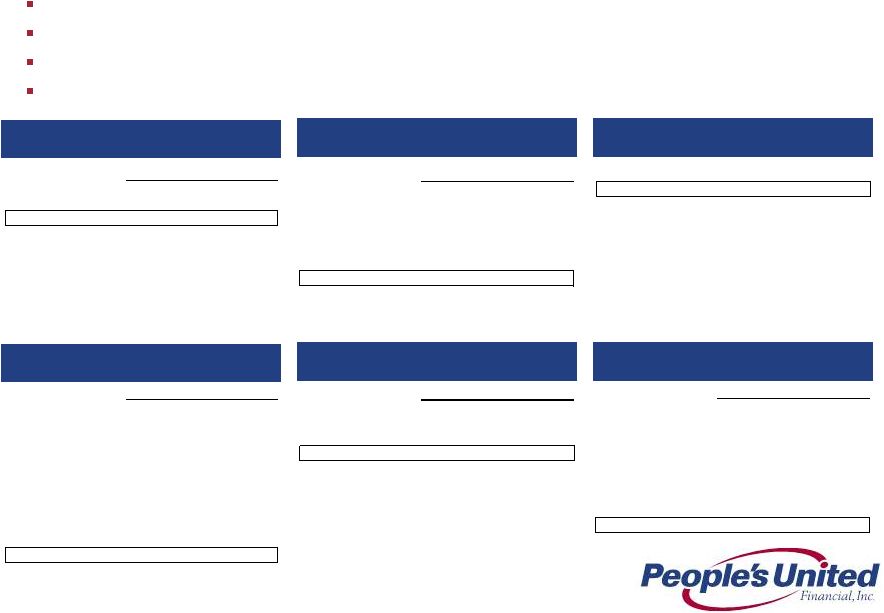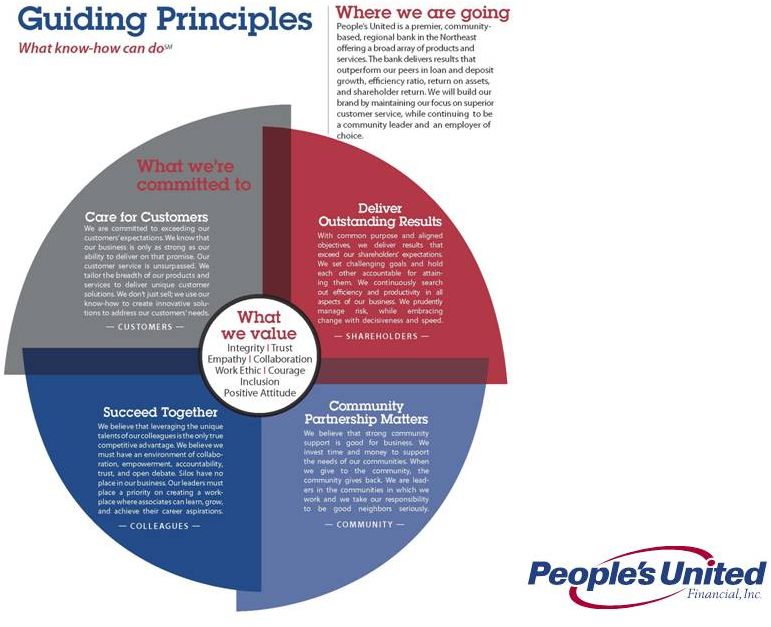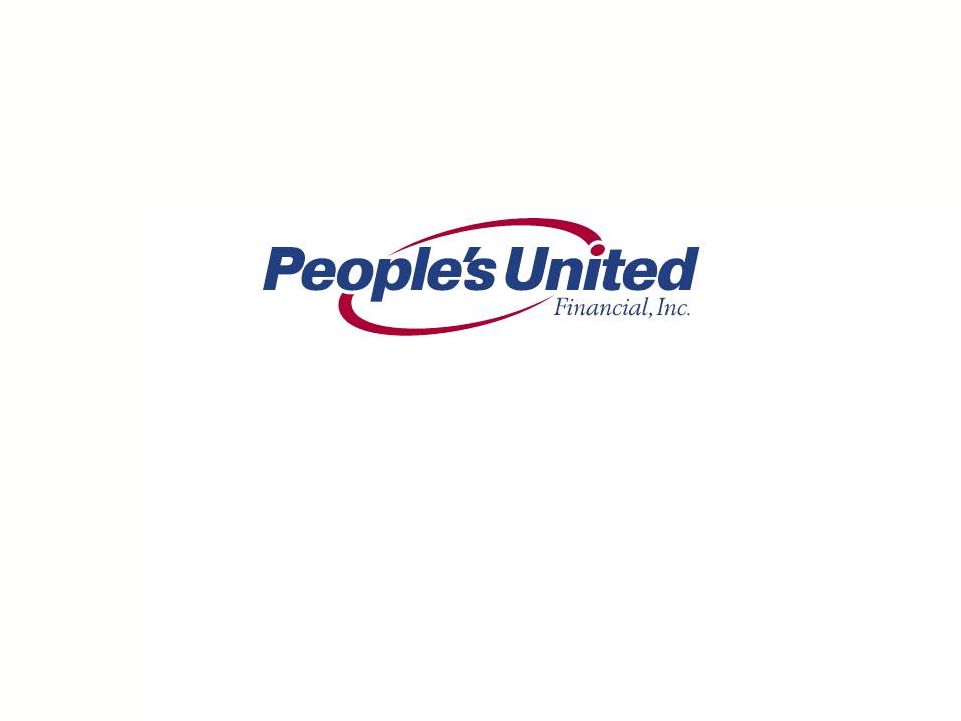Attached files
| file | filename |
|---|---|
| 8-K - FORM 8-K - People's United Financial, Inc. | d409500d8k.htm |
 Barclays Global Financial Services Conference
September 11, 2012
Investor Contact:
Peter Goulding, CFA
203-338-6799
peter.goulding@peoples.com
Exhibit 99.1 |
 1
Certain statements contained in this release are forward-looking in nature. These include all
statements about People's United Financial's plans, objectives, expectations and other
statements that are not historical facts, and usually use words such as "expect,"
"anticipate," "believe" and similar expressions. Such statements represent
management's current beliefs, based upon information available at the time the statements are
made, with regard to the matters addressed. All forward-looking statements are subject to
risks and uncertainties that could cause People's United Financial's actual results or financial condition
to differ materially from those expressed in or implied by such statements. Factors of particular
importance to People’s United Financial include, but are not limited to: (1) changes in
general, national or regional economic conditions; (2) changes in interest rates; (3) changes
in loan default and charge-off rates; (4) changes in deposit levels; (5) changes in levels
of income and expense in non-interest income and expense related activities; (6)
residential mortgage and secondary market activity; (7) changes in accounting and regulatory
guidance applicable to banks; (8) price levels and conditions in the public securities markets
generally; (9) competition and its effect on pricing, spending, third-party relationships
and revenues; (10) the successful integration of acquired companies; and (11) changes in regulation
resulting from or relating to financial reform legislation. People's United Financial does not
undertake any obligation to update or revise any forward-looking statements, whether as a
result of new information, future events or otherwise.
Forward Looking Statement |
 2
Corporate Overview
Snapshot, as of June 30, 2012
People’s United Financial, Inc.
NASDAQ (PBCT)
Headquarters:
Bridgeport, CT
Chief Executive Officer:
Jack Barnes
Chief Financial Officer:
Kirk Walters
Market Capitalization (9/10/12):
$4.3 billion
Assets:
$28.1 billion
Loans:
$20.6 billion
Deposits:
$21.5 billion
Branches:
416
ATMs:
634
Standalone ATMs:*
83
Founded:
1842
* Includes 25 ATMs in Stop & Shop locations where a branch is not
present. |
 3
Branch Map |
 4
Strategic Vision Outlined in mid-2010
Optimize the Existing Business
Continue to grow high quality, in-footprint, relationship-based C&I,
commercial real estate, home equity and select residential loans
Maintain conservative underwriting standards and focus on asset quality
Compete on service and relationships and maintain pricing discipline
Yield enhancing moves on investments without credit risk or significant duration
risk Further leverage our brand
Deepen our presence in NYC Metro (Westchester County and Long Island) and Greater
Boston Continue to upgrade our products & services
Build out our small business lending capabilities
Continue to deepen wealth management and insurance relationships
Improved infrastructure facilitates future growth
Core systems conversion complete
Our objective is to reach 1.25% ROAA |
 5
Substantial Progress Since 1Q 2010
Continued to build on our premium brand
Expanding footprint into two of the largest MSAs in the country (NYC, #1 and
Boston, #10)
NYC MSA: 5 branches in 2010, nearly 100 branches in 2012
Boston MSA: 20 branches in 2010, nearly 60 branches in 2012
Attracted senior level talent to augment an already strong leadership team
Significantly enhanced corporate governance and risk capabilities
Maintained superior asset quality with NCOs / Average Loans of 28 basis points
Lowered the efficiency ratio ~15%
from 76.1% in 1Q 2010 to 61.5% in 2Q 2012
Improved profitability as demonstrated by an EPS CAGR of 100%
Operating ROAA has nearly doubled from 55bps in 1Q10 to 97bps in
2Q12
Returned over $1.1BN of capital to shareholders through dividends and share
repurchases –
25% of our current market capitalization
All of this has occurred while the US economy and economic outlook has
weakened -
10 Year Treasury Yield: 3.83%, Mar. 31, 2010; 1.67%, Sept. 7, 2012
|
 6
Acquisitions of Smithtown and RiverBank
–
Solidified franchise expansion into the greater Boston and New York metro
MSAs –
Complements de novo activity in both markets
Acquisition of Danvers
–
Deepened relationships in the Boston MSA, New England’s largest market, and
nearly doubled existing Massachusetts footprint
–
Created seventh largest bank in both Massachusetts and the Boston market
Acquisition of Select Citizens Bank Branches
–
Unique opportunity based on People’s United’s excellent in-store
branch banking track record, longstanding relationship with Stop & Shop
and strong existing traditional branch network in the market –
83% of in-store branches in Nassau/Suffolk counties of Long Island are within 5
miles of a traditional branch and 75% of in-store branches in
Westchester County are within 5 miles of a traditional branch –
Added additional source of core deposit funding
Record of Successful Acquisitions
Acquisition Integration as a Core Competency
Since 2010, People’s United has completed several acquisitions that have deepened its
presence in Boston and the
New York metro area |
 7
Loans
Deposits
Growing Future Earnings Per Share
Loans and Deposits per Share
$60.49
$14
$15
$16
$17
$18
$19
$20
$21
$22
1Q10
2Q10
3Q10
4Q10
1Q11
2Q11
3Q11
4Q11
1Q12
2Q12
$40
$45
$50
$55
$60
$65
Gross Loans ($BN)
Loans per Share
$62.99
$14
$15
$16
$17
$18
$19
$20
$21
$22
1Q10
2Q10
3Q10
4Q10
1Q11
2Q11
3Q11
4Q11
1Q12
2Q12
$40
$45
$50
$55
$60
$65
Deposits ($BN)
Deposits per share
We have made substantial progress since the first quarter of 2010, growing loans and deposits
at compound annual growth rates greater than peers by approximately 14% |
 8
Deepening Market Presence
Connecticut
Massachusetts
Vermont
New York
New Hampshire
Maine
Leading
market
position
in
the
best
commercial
banking
market
in
the
US
#1 in Fairfield County, CT, 65 branches, $5.7BN, 17.8% market share
#2 in Essex County, MA, 21 branches, $1.9BN, 11.2% market share
#5 deposit market share in New England
Source: SNL Financial
Branches
$BN
%
1
B of A
158
24.1
24.3
2
Webster
124
11.4
11.5
3
People's United
166
10.1
10.2
4
Wells Fargo
75
8.0
8.1
5
TD Bank
81
5.5
5.5
6
First Niagara
82
4.9
5.0
7
JPM Chase
55
4.0
4.1
8
Citi
20
2.8
2.9
9
Liberty
45
2.7
2.7
10
RBS
50
2.4
2.5
Branches
$BN
%
1
B of A
269
52.5
22.8
2
RBS
254
28.4
12.3
3
Santander
228
15.4
6.7
4
TD Bank
158
9.7
4.2
5
Eastern Bank
94
6.2
2.7
6
Independent Bank
78
4.1
1.8
7
People's United
58
3.5
1.5
8
Middlesex
31
3.4
1.5
9
Boston Private
12
2.7
1.2
10
Salem Five
30
2.2
1.0
Branches
$BN
%
1
People's United
45
2.4
22.4
2
TD Bank
37
2.3
21.5
3
Merchants
33
1.1
10.1
4
RBS
21
0.7
6.9
5
KeyCorp
13
0.7
6.5
6
Northfield
13
0.5
4.7
7
Community
14
0.4
3.9
8
Union
13
0.4
3.4
9
Passumpsic
7
0.3
3.0
10
Berkshire Hills
7
0.3
3.0
Branches
$BN
%
1
JPM Chase
850
351.2
35.7
2
B of A
369
65.7
6.7
3
Citi
261
64.6
6.6
4
HSBC
174
53.0
5.4
5
Capital One
287
35.9
3.7
6
M&T
269
24.1
2.4
7
TD Bank
213
20.4
2.1
8
Wells Fargo
86
19.2
2.0
9
KeyCorp.
270
18.3
1.9
10
First Niagara
229
17.1
1.7
37
People's United
96
2.6
0.3
Branches
$BN
%
1
TD Bank
56
12.5
40.6
2
KeyCorp
61
2.5
8.0
3
Camden National
51
1.9
6.2
4
Bangor Bancorp
58
1.8
6.0
5
B of A
20
1.3
4.2
6
First Bancorp
15
1.0
3.4
7
Machias
14
0.8
2.6
8
Bar Harbor
16
0.8
2.5
9
People's United
30
0.8
2.5
10
Norway
20
0.7
2.3
Branches
$BN
%
1
RBS
81
6.8
27.8
2
TD Bank
73
5.2
21.1
3
B of A
31
2.2
9.0
4
People's United
32
1.3
5.3
5
Merrimack
18
1.0
3.9
6
LSB Financial
23
0.9
3.6
7
Santander
20
0.8
3.4
8
NH Thrift
19
0.6
2.6
9
Northway
17
0.6
2.4
10
Centrix
6
0.6
2.4
Leading market position in the best commercial banking market in the US |
 9
Cross-sell
Educating our employee base / breaking down silo thinking
Geographic cross-sell leadership teams in place
Leveraging technology
3.70 retail products per retail household
680,000 retail households
Retail households grew by approximately 40,000 households or 7% during the last
twelve months
Penetration rates are measured and monitored closely
Residential mortgage, home equity, wealth management and brokerage offer large
opportunities
Cross-sell performance becoming an increasingly important part of
compensation |
 10
Growing loans and deposits organically
Continue to grow in existing markets
We have large markets where we are under-represented with an outstanding brand to
leverage Lower deposit costs
Improve DDA mix, commercial mix
Lower deposit costs on acquired deposits
Strengthen fee income
Continue to reduce absolute expense levels on a pro forma basis
Operating Leverage
Grow Revenue While Reducing Expenses |
 11
Fortified Foundation for Growth
Our Relationship Based World |
 12
Market Positioning
What know-how can do |
 13
In
addition
to
evaluating
People’s
United
Financial’s
results
of
operations
in
accordance
with
U.S.
generally
accepted
accounting
principles
(“GAAP”),
management
routinely
supplements
this
evaluation
with
an
analysis
of certain non-GAAP financial measures, such as the efficiency and tangible equity ratios,
tangible book value per share and operating earnings metrics. Management believes these
non-GAAP financial measures provide information
useful
to
investors
in
understanding
People’s
United
Financial’s
underlying
operating
performance
and trends, and facilitates comparisons with the performance of other banks and thrifts. Further, the
efficiency ratio and operating earnings metrics are used by management in its assessment of
financial performance, including non-interest expense control, while the tangible equity
ratio and tangible book value per share are used
to
analyze
the
relative
strength
of
People’s
United
Financial’s
capital
position.
The
efficiency
ratio,
which
represents
an
approximate
measure
of
the
cost
required
by
People’s
United
Financial
to
generate
a
dollar
of
revenue,
is
the
ratio
of
(i)
total
non-interest
expense
(excluding
goodwill
impairment charges, amortization of other acquisition-related intangibles, losses on real estate
assets and non-recurring
expenses)
(the
numerator)
to
(ii)
net
interest
income
on
a
fully
taxable
equivalent
("FTE")
basis
plus total non-interest income (including the FTE adjustment on bank-owned life insurance
("BOLI") income, and excluding gains and losses on sales of assets other than
residential mortgage loans, and non-recurring income) (the denominator). People’s
United Financial generally considers an item of income or expense to be non-recurring if it
is not similar to an item of income or expense of a type incurred within the last two years and
is not similar to an item of income or expense of a type reasonably expected to be incurred within the
following two years.
Non-GAAP Financial Measures and Reconciliation to GAAP
|
 14
Operating earnings exclude from net income those items that management considers to be of such a
non- recurring or infrequent nature that, by excluding such items (net of income taxes),
People’s United Financial’s results can be measured and assessed on a more consistent
basis from period to period. Items excluded from operating earnings, which include, but are not
limited to, merger-related expenses, charges related to executive-level
management
separation
costs,
severance-related
costs
and
writedowns
of
banking
house
assets, are generally also excluded when calculating the efficiency ratio. Operating earnings
per share is calculated by dividing operating earnings by the weighted average number of
dilutive common shares outstanding for the respective period. Operating return on average
assets is calculated by dividing operating earnings (annualized) by average assets. Operating
return on average tangible stockholders' equity is calculated by dividing operating earnings
(annualized) by average tangible stockholders' equity. The operating dividend payout ratio is
calculated by dividing dividends paid by operating earnings for the respective period. Operating
net interest margin excludes from the net interest margin those items that management considers to
be of such a discrete nature that, by excluding such items, People’s United Financial’s net
interest margin can be measured and assessed on a more consistent basis from period to period.
Items excluded from operating net
interest
margin
include
cost
recovery
income
on
acquired
loans
and
changes
in
the
accretable
yield
on
acquired loans stemming from periodic cash flow reassessments. Operating net interest margin is
calculated by dividing operating net interest income (annualized) by average earning
assets. Non-GAAP Financial Measures and Reconciliation to GAAP
|
 15
The
tangible
equity
ratio
is
the
ratio
of
(i)
tangible
stockholders’
equity
(total
stockholders’
equity
less
goodwill
and
other
acquisition-related
intangibles)
(the
numerator)
to
(ii)
tangible
assets
(total
assets
less
goodwill
and
other acquisition-related intangibles) (the denominator). Tangible book value per share is
calculated by dividing tangible stockholders’
equity by common shares (total common shares issued, less common shares
classified as treasury shares and unallocated Employee Stock Ownership Plan ("ESOP")
common shares). In light of diversity in presentation among financial institutions, the
methodologies used by People’s United Financial for determining the non-GAAP financial
measures discussed above may differ from those used by other financial institutions.
Non-GAAP Financial Measures and Reconciliation to GAAP
|
 For
more information, investors may contact: Peter Goulding, CFA
203-338-6799
peter.goulding@peoples.com |
